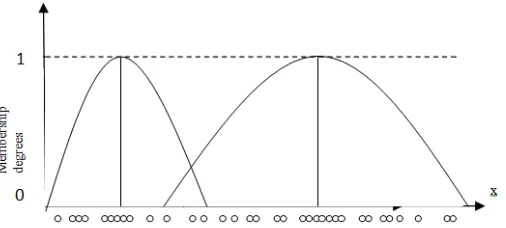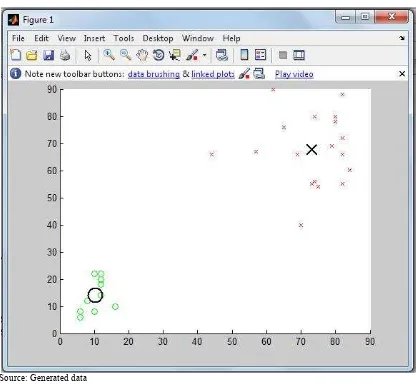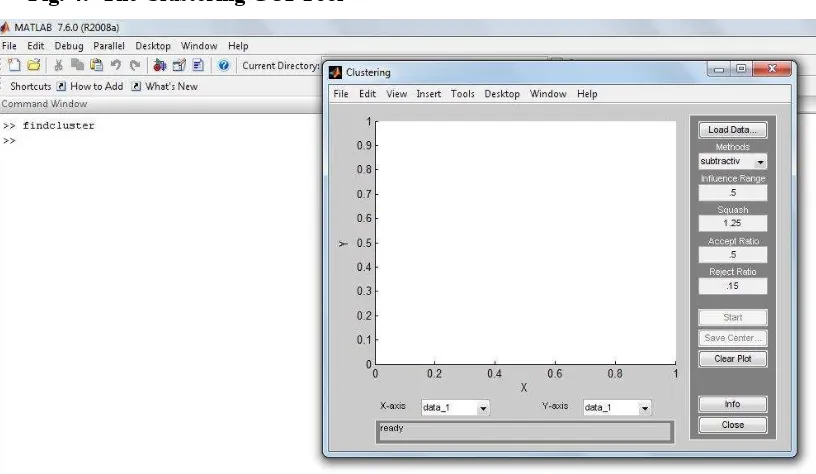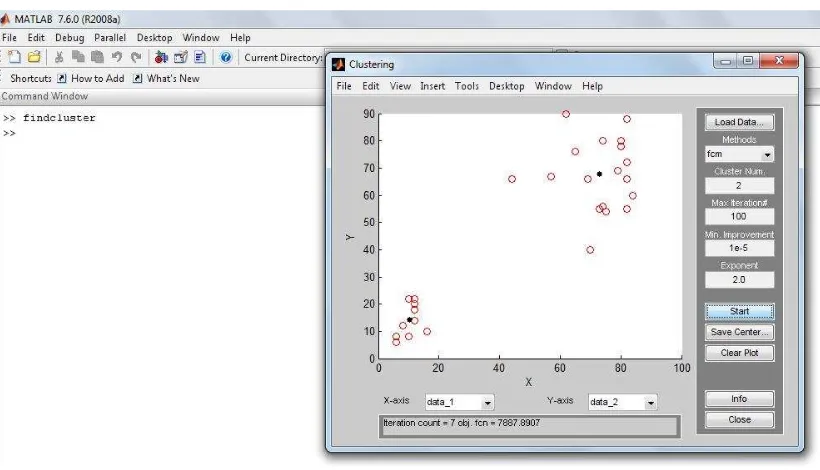905
FUZZY C - MEANS CLUSTERING IN MATLAB
Makhalova Elena
Abstract
Paper is a survey of fuzzy logic theory applied in cluster analysis. Fuzzy logic becomes more and more important in modern science. It is widely used: from data analysis and forecasting to complex control systems. In this article we consider clustering based on fuzzy logic, named Fuzzy Clustering. Clustering involves the task of dividing data points into homogeneous classes or clusters so that items in the same class are as similar as possible and items in different classes are as dissimilar as possible. (Řezanková, 2013). In hard clustering, data is divided into crisp clusters, where each data point belongs to exactly one cluster. In fuzzy clustering, the data points can belong to more than one cluster, and associated with each of the points are membership grades which indicate the degree to which the data points belong to the different clusters. There are many methods of Fuzzy Clustering nowadays. In our work we review the Fuzzy c - means clustering method in MATLAB.
Key words: Fuzzy clustering; Fuzzy c – means; Hard c-means; MATLAB
JEL code: C18, C38, C69
Introduction
906
Actually, there are many programmes using Fuzzy C-Means Clustering, for instance: C++, MATLAB, R-ko. In this papir we will review Fuzzy C-Means Clustering in MATLAB.
1
Comparison Fuzzy c – means clustering algorithm with hard C –
means clustering algorithm
Let‘s start by considering, what is it fuzzy c-means clustering. We can see some differences in comparison with c-means clustering (hard clustering). Moreover, one should note here: c – means clustering algorithm is a starting point for the fuzzy extensions (Löster, 2012).
These algorythms are based on objective functions J, which are mathematical criterial that quantify the goodness of cluster models that comprise prototypes and data partition. Objective functions serve as cost functions that have to be minimized to obtain optimal cluster solutions (Řezanková, 2011). Thus, for each of the following cluster models the respective objective function expresses desired properties of what should be regarded as ‘‘best’’ results of the cluster algorithm. Steps of the algorithm follow from the optimization scheme that they apply to approach the optimum of J. Thus, in our paper of the hard and fuzzy c-means we discuss their respective objective functions first. In their basic forms the hard and fuzzy algorithms look for a predefined number of c clusters in a given data-set, where each of the clusters is represented by its center vector (Zheru, 1996). However, hard and fuzzy differ in the way they assign data to clusters, i.e., what type of data partitions they form.
The main advantage of fuzzy c – means clustering, it allows gradual memberships of data points to clusters measured as degrees in [0,1]. This gives the flexibility to express that data points can belong to more than one cluster (Höppper, 2000).
Fig. 1a: Hard c-means clustering Fig. 1b: Fuzzy c – means clustering
907
belongs to more than one cluster (fuzzy clustering) with degree of membership between data and centers of clusters. Figure 2a and 2b illustrate this idea. A hard clustering can be obtained from a fuzzy partition by thresholding the membership value (Gan, 2007).
Fig. 2a: Hard clustering.
Fig. 2b: Fuzzy clustering.
Membership degrees can also express how ambiguously or definitely a data point should belong to a cluster (Löster, 2012). So, this partitioning is carried out through an iterative optimization of the objective function, with the update of membership ( ) and the cluster centers ( ). This function show below:
= ∑
∑
−
,
1 ≤
≤ ∞
(1)Larger membership values indicate higher confidence in the assignment of the pattern to the cluster. Fuzzy partitioning is carried out through an iterative optimization of the objective function shown above, with the update of membership and the cluster centers (De Oliveria, 2007), by:
1
0 x
M
em
be
rs
hi
p
de
gre
908 criterion between 0 and 1, whereas k are the iteration steps. This procedure converges to a local minimum of (Meloun, 2006).
The algorithm is composed of the following steps:
1. Initialization Selected the following parameters:
• the required number of clusters N,
2 <N <k;
• measure distances as Euclidean distance; • a fixed parameter q (usually 1.5);
• initial (at zero iteration) matrix ( ) =
( )( ) object ownership with the given
initial cluster centers (Everitt, 2011). 2. Calculate the centers vectors C(k)=[cj]
with U(k)
In the t-th iteration step in the known matrix is computed in accordance with the above solution of differential equations (Everitt, 2011).
=∑∑ ∗
3. Modified membership measure = 1
∑ ‖ − ‖−
4. If || ( ) - ( )|| < ɛ then STOP;
otherwise return to step 2.
909
ɛ - predetermined level of accuracy.
2
Fuzzy c – means clustering in MATLAB
In this abstrakt we consider the simple case of a Fuzzy c – means clustering in MATLAB. For clarity, we restrict ourselves to the simplest form of cluster prototypes. The data set has n=45 points in an s=3 dimensional space. There are two ways solve this in MATLAB: using the command line or graphical user interface. Consider the first of these methods.
To find the cluster centers in MATLAB we can with the help fcm function (built-in function), which is given below.
Description of function:
[center, U, obj_fcm] = fcm(data,cluster_ n)
The arguments of this function are:
1) data - lots of data to be clustering, each line describes a point in a multidimensional feature space;
2) cluster_n - number of clusters (more than one). The function returns the following parameters:
1) center - the matrix of cluster centers, where each row contains the coordinates of the center of an individual cluster;
2) U - resulting matrix;
3) obj_fcn - the objective function value at each iteration.
So, for this example we should write (results are shown in Figure 3):
910
Fig. 3: Results of the C - means fuzzy clustering in MATLAB
Source: Generated data
Tab. 1: Results of iterations
Number of iteration count Value of the objective function Iteration count = 1 obj. fcn = 169197.014483 Iteration count = 2 obj. fcn = 117766.228513 Iteration count = 3 obj. fcn = 21602.841537 Iteration count = 4 obj. fcn = 7893.034365 Iteration count = 5 obj. fcn = 7887.892094 Iteration count = 6 obj. fcn = 7887.890663 Iteration count = 7 obj. fcn = 7887.890662
Source: Generated data
911
The Clustering GUI Tool shown in the next figure (Figure 4) lets you perform the following tasks:
1. Load and plot the data. 2. Start the clustering. 3. Save the cluster center.
Fig. 4: The Clustering GUI Tool
Source: Generated data
Let's consider each of tasks.
1. Loading and Plotting the Data (shown in Fig.5)
To load a data set in the GUI, perform either of the following actions: a. Click Load Data, and select the file containing the data.
912
Fig. 5: Loading and Plotting the Data
Source: Generated data
2. The Clustering GUI Tool works on multidimensional data sets, but displays only two of those dimensions on the plot. To select other dimensions in the data set for plotting, you can use the drop-down lists under X-axis and Y-axis.
3. Starting the Clustering
To start clustering the data: choose the clustering function fcm (fuzzy C-Means clustering) from the drop-down menu under Methods.
Set options for the selected method using the Influence Range, Squash, Aspect Ratio, and Reject Ratio fields. Begin clustering by clicking Start.
4. Save the cluster center.
After clustering gets completed, the cluster centers appear in black as shown in the next figure.
Conclusion
913
In the second phase of our research we plan to process real data from Spain, German and Russian banks in the same way.
Acknowledgment
This article was created with the help of the Internal Grant Agency of University of Economics in Prague No. 6/2013 under the title „Evaluation of results of cluster analysis in Economic problems.”
References
[1] De Oliveira, J. V., & Pedrycz, W. (2007). Advances in fuzzy clustering and its applications. (1 ed., pp. 4-69). London: Wiley.
[2] Everitt, S., Landau, S., Leese, M. (2011). Cluster Analysis. (5 ed., pp. 76-80). London: Wiley.
[3] Gan, G., Ma, C., Wu, J. (2007). Data Clustering: Theory, Algorithms, and Applications. (1 ed., pp. 18-25). London: Wiley.
[4] Höppper, F., Klawonn, F., Krause, R., & Runkler, T. (2000). Fuzzy cluster analisys. (2 ed., pp. 5-17). New York: Wiley.
[5] Meloun, M., Militký, J. (2006). Kompendium statistického zpracování dat. (2 ed., pp. 279-295). Prague: Academy.
[6] Zheru, C., Hong, Y., & Tuan, P. (1996). Fuzzy algorithms : with applications to image processing and pattern recognition. (Vol. 10, pp. 57-58, 86-89). Singapore: World Scientific Publishing.
[7] Loster, T., & Langhamrova, J. (2012). Disparities between regions of the czech republic for non-business aspects of labour market. In Loster Tomas, Pavelka Tomas (Eds.), 6th International Days of Statistics and Economics (pp. 689-702). ISBN 978-80-86175-86-7 [8] Löster, T. (2012). Hodnocení výsledků fuzzy shlukování. International collection of scientific work on the occasion of 60th anniversary of university education at faculty of Business Economy with seat in Košice of University of Economics in Bratislava, 1–14. ISBN 978-80-86175-80-5.
[9] Löster, T. (2012). Kritéria pro hodnocení výsledků shlukování se známým zařazením do skupin založená na konfuzní matici. Retrieved from
914
[10] Řezanková, H., Löster, T., & Húsek, D. (2011). Evaluation of categorical data clustering. Advances in Intelligent Web Mastering, 3, 173–182. ISBN 978-3-642-18028-6. ISSN 1867-5662.
[11] Řezanková, H., Löster, T. (2013). Shluková analýza domácnosti charakterizovaných kategoriálními ukazateli. E+M. Ekonomie a Management, 16(3), 139-147. ISSN: 1212-3609
Contact
Makhalova Elena University of Economics



